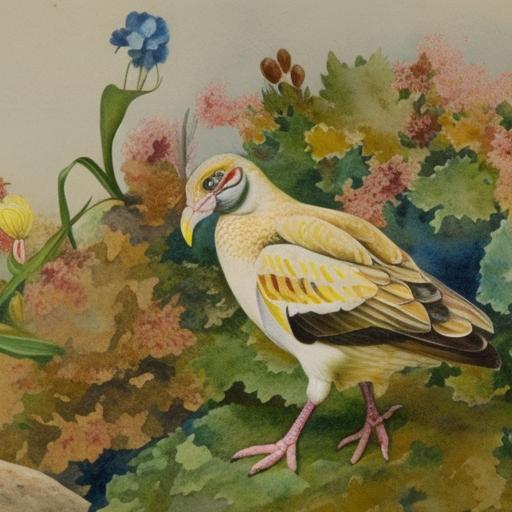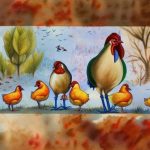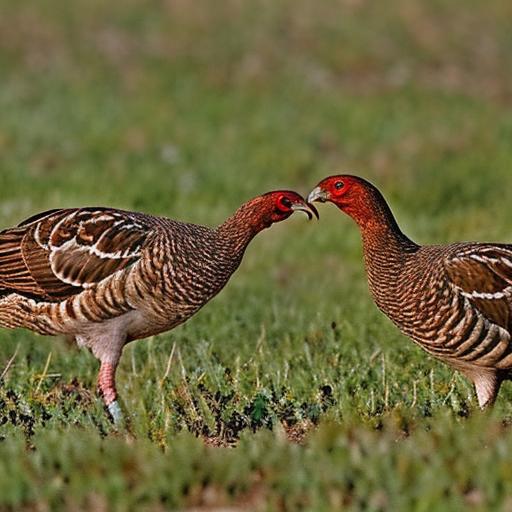Turkey selective breeding is a process that has been utilized for centuries to improve the genetics of turkeys for various purposes such as increased size and weight, improved meat quality, healthier birds, enhanced reproductive efficiency, resistance to diseases, and the development of diverse breeds and varieties. Selective breeding involves carefully choosing which turkeys to breed based on specific desirable traits, such as size, weight, meat quality, and disease resistance, in order to produce offspring with these desired characteristics. This process has been crucial in the development of the modern turkey industry, as it has allowed for the production of turkeys that are more efficient to raise, provide higher quality meat, and are more resistant to diseases.
Selective breeding has played a significant role in the evolution of the turkey industry, as it has allowed for the development of turkeys that are better suited for commercial production. Through careful selection and breeding, turkey breeders have been able to create turkeys that are larger and heavier, have improved meat quality, are healthier, have enhanced reproductive efficiency, and are more resistant to diseases. This has led to the production of turkeys that are more economically viable for farmers and provide consumers with higher quality meat. The process of selective breeding has also led to the development of diverse breeds and varieties of turkeys, each with their own unique characteristics and traits that make them suitable for different purposes and environments.
Key Takeaways
- Turkey selective breeding has been used to improve the size, weight, meat quality, health, reproductive efficiency, and disease resistance of turkeys.
- Through selective breeding, turkeys have been bred to increase in size and weight, resulting in larger and more meaty birds.
- Selective breeding has also led to improved meat quality in turkeys, making them more desirable for consumption.
- Healthier birds have been achieved through selective breeding, resulting in stronger immune systems and overall better well-being.
- Enhanced reproductive efficiency and resistance to diseases are also benefits of selective breeding, contributing to the overall success of turkey farming.
Increased Size and Weight
One of the primary goals of turkey selective breeding has been to increase the size and weight of turkeys. Through careful selection and breeding, turkey breeders have been able to develop turkeys that are significantly larger and heavier than their wild counterparts. This has been achieved through the selection of turkeys with desirable growth traits and the breeding of these individuals to produce offspring with even greater size and weight. As a result, modern commercial turkeys are much larger and heavier than their ancestors, making them more economically viable for farmers and providing consumers with a greater quantity of meat.
The increased size and weight of modern turkeys have been achieved through the careful selection and breeding of individuals with desirable growth traits. This has led to the development of turkeys that are capable of reaching much larger sizes and weights than their wild counterparts. The increased size and weight of modern turkeys have made them more economically viable for farmers, as they are able to produce a greater quantity of meat per bird. Additionally, consumers benefit from the increased size and weight of modern turkeys, as they are able to purchase larger cuts of meat that provide more servings per bird.
Improved Meat Quality
In addition to increased size and weight, turkey selective breeding has also focused on improving the quality of turkey meat. Through careful selection and breeding, turkey breeders have been able to develop turkeys that produce meat with superior taste, texture, and nutritional value. This has been achieved through the selection of turkeys with desirable meat traits, such as tenderness, juiciness, and flavor, and the breeding of these individuals to produce offspring with even better meat quality. As a result, modern commercial turkeys produce meat that is much higher in quality than their wild counterparts, providing consumers with a superior product.
The improved meat quality of modern turkeys has been achieved through the careful selection and breeding of individuals with desirable meat traits. This has led to the development of turkeys that produce meat with superior taste, texture, and nutritional value. The improved meat quality of modern turkeys has made them more desirable for consumers, as they are able to purchase turkey meat that is tender, juicy, flavorful, and nutritious. Additionally, the improved meat quality of modern turkeys has made them more economically viable for farmers, as they are able to sell a higher quality product at a premium price.
Healthier Birds
Another important aspect of turkey selective breeding is the development of healthier birds. Through careful selection and breeding, turkey breeders have been able to develop turkeys that are more resistant to diseases and have overall better health. This has been achieved through the selection of turkeys with desirable health traits, such as strong immune systems and resistance to common diseases, and the breeding of these individuals to produce offspring with even better health characteristics. As a result, modern commercial turkeys are much healthier than their wild counterparts, leading to reduced mortality rates and lower veterinary costs for farmers.
The development of healthier birds through turkey selective breeding has been crucial in improving the overall welfare and productivity of commercial turkey flocks. By selecting for desirable health traits and breeding individuals with strong immune systems and disease resistance, turkey breeders have been able to develop turkeys that are less susceptible to common diseases and have overall better health. This has led to reduced mortality rates in commercial turkey flocks, as well as lower veterinary costs for farmers. Additionally, healthier birds are more efficient at converting feed into meat, leading to improved feed efficiency and lower production costs.
Enhanced Reproductive Efficiency
Turkey selective breeding has also focused on enhancing the reproductive efficiency of turkeys. Through careful selection and breeding, turkey breeders have been able to develop turkeys that have improved fertility rates, hatchability rates, and overall reproductive performance. This has been achieved through the selection of turkeys with desirable reproductive traits, such as high fertility and hatchability rates, and the breeding of these individuals to produce offspring with even better reproductive efficiency. As a result, modern commercial turkeys are much more efficient at reproducing than their wild counterparts, leading to higher production rates and lower breeding costs for farmers.
The enhanced reproductive efficiency of modern turkeys has been achieved through the careful selection and breeding of individuals with desirable reproductive traits. This has led to the development of turkeys that have improved fertility rates, hatchability rates, and overall reproductive performance. The enhanced reproductive efficiency of modern turkeys has made them more economically viable for farmers, as they are able to produce larger quantities of offspring at a lower cost. Additionally, enhanced reproductive efficiency leads to higher production rates, allowing farmers to meet consumer demand for turkey products.
Resistance to Diseases

One of the key benefits of turkey selective breeding is the development of turkeys that are more resistant to diseases. Through careful selection and breeding, turkey breeders have been able to develop turkeys that have improved immune systems and resistance to common diseases. This has been achieved through the selection of turkeys with desirable disease resistance traits and the breeding of these individuals to produce offspring with even better disease resistance. As a result, modern commercial turkeys are much less susceptible to common diseases than their wild counterparts, leading to reduced disease outbreaks and lower veterinary costs for farmers.
The development of disease-resistant turkeys through selective breeding has been crucial in improving the overall health and productivity of commercial turkey flocks. By selecting for desirable disease resistance traits and breeding individuals with strong immune systems, turkey breeders have been able to develop turkeys that are less susceptible to common diseases. This has led to reduced disease outbreaks in commercial turkey flocks, as well as lower veterinary costs for farmers. Additionally, disease-resistant turkeys are more economically viable for farmers, as they require fewer medical interventions and treatments.
Diverse Breeds and Varieties
Turkey selective breeding has also led to the development of diverse breeds and varieties of turkeys, each with their own unique characteristics and traits. Through careful selection and breeding, turkey breeders have been able to create a wide range of turkey breeds that are suited for different purposes and environments. This includes breeds that are specifically bred for meat production, egg production, exhibition purposes, or conservation efforts. Each breed has its own distinct physical appearance, temperament, growth rate, egg production rate, and other characteristics that make it suitable for specific uses.
The development of diverse breeds and varieties of turkeys through selective breeding has provided farmers with a wide range of options for their production needs. Whether they are looking for turkeys that excel in meat production, egg production, or exhibition purposes, there is a breed or variety that meets their specific requirements. Additionally, the development of diverse breeds and varieties has allowed for the preservation of rare or heritage breeds that may be at risk of extinction. This diversity also provides consumers with a range of options when it comes to purchasing turkey products, allowing them to choose products that align with their values or preferences.
In conclusion, turkey selective breeding has played a crucial role in the evolution of the turkey industry by improving various aspects such as increased size and weight, improved meat quality, healthier birds, enhanced reproductive efficiency, resistance to diseases, and the development of diverse breeds and varieties. Through careful selection and breeding practices, turkey breeders have been able to develop turkeys that are more economically viable for farmers while providing consumers with higher quality products. The continued advancement in selective breeding techniques will further contribute to the improvement of the turkey industry by addressing emerging challenges such as environmental sustainability and animal welfare concerns.
Selective breeding in turkeys has resulted in significant changes in their size, growth rate, and meat production. This process has led to the development of turkey breeds that are specifically bred for their meat production and have significantly larger breast muscles compared to their wild counterparts. To learn more about the impact of selective breeding on poultry, you can read an interesting article on PoultryWizard that discusses the importance of providing adequate space for chickens in a coop and how selective breeding has influenced the housing needs of poultry.
FAQs
What is selective breeding?
Selective breeding is the process of choosing specific animals or plants with desirable traits to breed in order to produce offspring with those same desirable traits. This process is used to improve the genetics of a species over time.
What traits are typically selected for in turkey breeding?
In turkey breeding, traits such as size, meat quality, growth rate, and disease resistance are typically selected for. Breeders aim to produce turkeys that are larger, grow faster, and have better meat quality while also being resistant to common diseases.
What has selective breeding resulted in for turkeys?
Selective breeding has resulted in turkeys that are larger, grow faster, and have improved meat quality compared to their wild counterparts. This has led to the production of turkeys that are more efficient for meat production.
What are some potential drawbacks of selective breeding in turkeys?
Some potential drawbacks of selective breeding in turkeys include reduced genetic diversity, which can make the population more susceptible to diseases and environmental changes. Additionally, there may be welfare concerns related to rapid growth and larger body size in turkeys.
How does selective breeding impact the turkey industry?
Selective breeding has significantly impacted the turkey industry by improving the efficiency of meat production. It has allowed for the production of turkeys that grow faster and have better meat quality, ultimately benefiting the industry economically.
Meet Walter, the feathered-friend fanatic of Florida! Nestled in the sunshine state, Walter struts through life with his feathered companions, clucking his way to happiness. With a coop that’s fancier than a five-star hotel, he’s the Don Juan of the chicken world. When he’s not teaching his hens to do the cha-cha, you’ll find him in a heated debate with his prized rooster, Sir Clucks-a-Lot. Walter’s poultry passion is no yolk; he’s the sunny-side-up guy you never knew you needed in your flock of friends!







